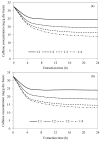Numerical Investigation of Conventional and Ultrasound-Assisted Aqueous Extraction of Caffeine from Whole Green Robusta Coffee Beans: Extraction Enhancement via Changing of Extraction Water
- PMID: 40509481
- PMCID: PMC12155289
- DOI: 10.3390/foods14111956
Numerical Investigation of Conventional and Ultrasound-Assisted Aqueous Extraction of Caffeine from Whole Green Robusta Coffee Beans: Extraction Enhancement via Changing of Extraction Water
Abstract
To enhance the low-efficiency but potentially health and environmentally friendly aqueous decaffeination process, ultrasound-assisted aqueous extraction (UAAE) has recently been proposed. A novel concept of intermittent extraction water change to further enhance UAAE has also been mentioned, but not yet studied in detail. For this reason, a mathematical model that can be used to predict the concentration evolutions of caffeine during UAAE and conventional aqueous extraction (CAE) of whole green robusta coffee beans is herein proposed. The model consists of terms representing transient intra-bean caffeine and water diffusion as well as molar fluxes of caffeine and water on the bean surface. After validation, the model was used to investigate the effects of extraction temperature, bean-to-water mass ratio and frequency of extraction water change on caffeine concentration evolutions. Simulation results show that UAAE exhibits around 10% higher caffeine removal rates than CAE at all investigated conditions. Extraction temperature of 70 °C, bean-to-water ratio of 1:3, and extraction water change at every 1 h interval are noted as the most appropriate conditions for UAAE. The required extraction durations of UAAE under these conditions are 13 h and 24 h to meet the US and European Union standards, respectively.
Keywords: decaffeinated coffee; mass transfer; mathematical modeling; moisture content; process intensification; sonication.
Conflict of interest statement
The authors declare no conflicts of interest.
Figures







References
Grants and funding
LinkOut - more resources
Full Text Sources

